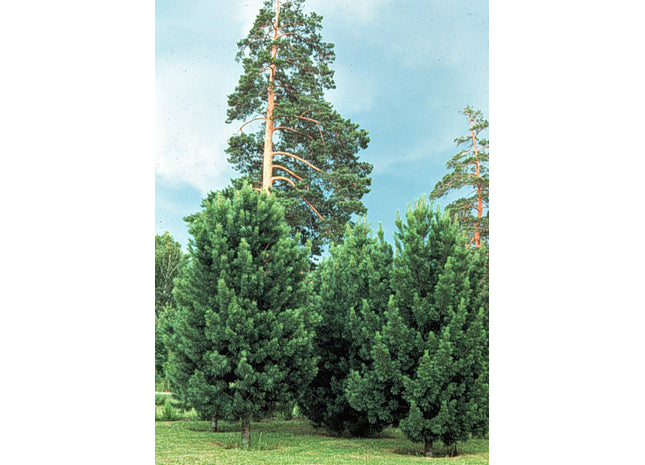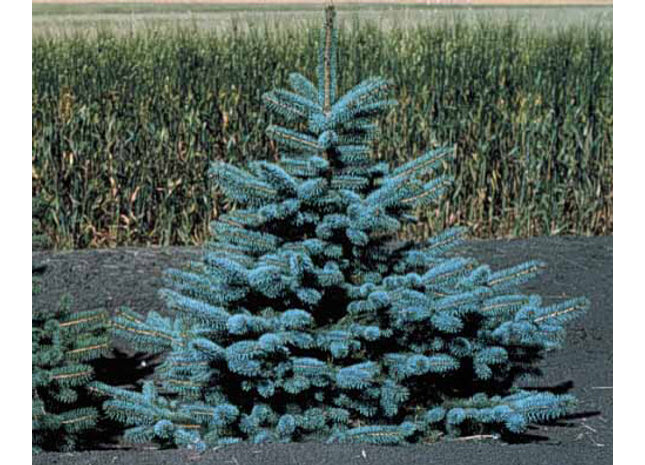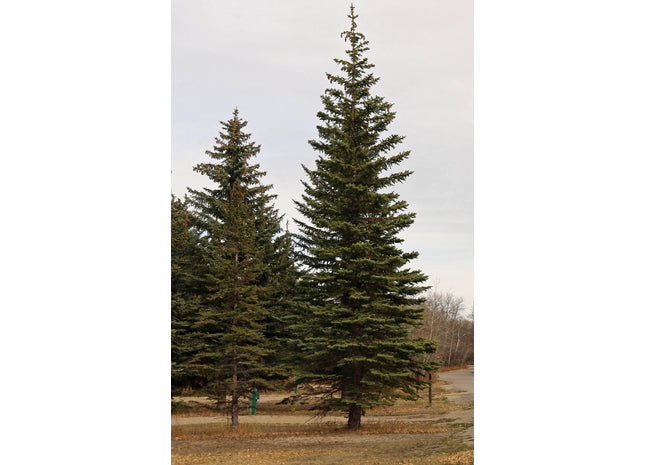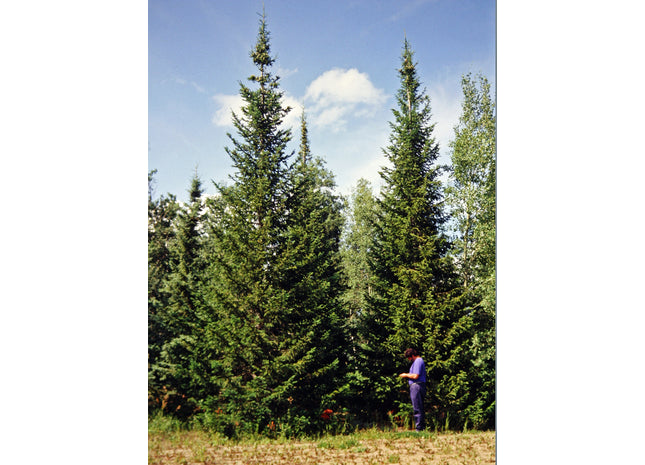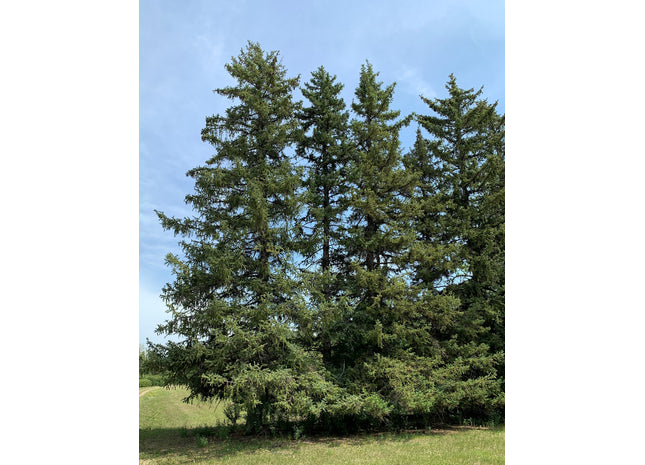Coniferous Tree Seeds

AgroForestry Solutions 'Lindquist' Siberian Larch Seed
Latin Name: Larix sibirica DESCRIPTION Family: Pinaceae Native Range: Northern Europe and Asia Seed Source: Seed production orchard near Indian Head Saskatchewan Height and Spread: 20m x 5m (25 years) Overview: The 'Lindquist' seed strain was developed specifically for tree planting in dry cold temperate regions of the Canadian prairies. It is a composite of parent trees selected from mature Siberian larch trees in southern Saskatchewan. It is named in honour of Carl Lindquist, propagation technician at the PFRA Tree Nursery from 1954 to 1984. 'Lindquist' Siberian larch grows on a wide variety of soils but favours loamy soils with pH 5.0 to 7.5. It is shade intolerant, preferring sunny exposure. It is characterized by a narrow upright crown and extreme hardiness (zone 1). Seed: dark brown, 2-4 cm long. Average viable seeds/packet: 640 SEED TREATMENT / SOWING Stratification: Soak seeds for 24 hours then stratify in moist sand for 45 days at 5C. Ideal sowing time: Fall outdoors or March indoors Sowing instructions: Outdoors - Sow 1 cm deep, 50 seeds/meter; Indoors - sow 3 seeds per cell 0.5 cm deep. Growing conditions: In spring, sow the stratified seeds in small pots filled with peat-based potting mix, covered just barely with 0.5 cm of additional potting mix. Place the containers in a bright location, but without too much direct sunlight, and continue to grow them until summer, when they can be placed outdoors in a shady location to continue growing. After one year the larch seedlings should be large enough to transplant to a permanent location. AGROFORESTRY VALUE 'Lindquist' Siberian larch is used as specimen trees or in hedges and windbreaks. It also does well in plantations. The dense, deep roots make it useful for soil stabilization. Its open crowns allow for uniform snow distribution adjacent to the windbreak. It has excellent wood quality for flooring and decking.
$20.00 - $25.00

'Baikal' Siberian Pine Seed
Latin Name: Pinus sibirica DESCRIPTION Family: Pinaceae Native Range: Native to Russia, specifically the Ural Mountains and Siberia. Seed Source: Siberian pine collection near Indian Head Saskatchewan. Height and Spread: 20m x 8m. Overview: Siberian pines are native to Siberia. The 'Baikal' seed strain originates from a collection made near Lake Baikal in Siberia in 1985. The collection was planted in a seed block near Indian Head, Saskatchewan. They are drought tolerant and our seeds are well adapted to northern temperate regions. The 'Baikal' seed strain has grown very well in southern Saskatchewan. It is ideally adapted for planting in non-boreal regions. Siberian pine grows well in heavy clay soils. Typically it has steady though not fast growth and is very tolerant of severe winter cold, hardy down to at least –60 °C, and also of wind exposure. Unlike other pines Siberian pine drop their needles mid-summer so don't be alarmed if your tree begins to turn shades of yellow from old needles dying in the summer. The needle drop is over after a few weeks Seeds: Yellow-brown and nut-like, 10-12 mm long. Average number of seeds/packet: 60 SEED TREATMENT / SOWING Stratification: Soak in water for 24 hours then warm stratify at 20°C for 60 days in moist sand followed by 120 days at 5°C. Ideal sowing time: Sow stratified seed outdoors in May or non-stratified seed in late August. Sowing instructions: Outdoors - sow 1.0 cm deep, 50 seeds/meter; Greenhouse - sow 3 seeds per cell. Growing conditions: Spring sowing of stratified seed is preferred over fall sowing of non-treated seeds. Alternatively, sow seed indoors then move outdoors in a shaded area during the summer. Sow stratified seeds in individual pots with well-drained potting soil. Push each seed just beneath the soil surface, making sure that it’s in a vertical position with the pointy end facing downward. Place the pots in a sunny window and water thoroughly. Keep the seeds moist and wait, as germination can take a few weeks. Plant seedlings into their permanent position within 2 years after sprouting, and mulch heavily before winter. Agroforestry Value 'Baikal' Siberian pine seeds are tasty and nutritious, they have been harvested and eaten by people for generations. In addition to its abundant crops of tasty nuts, Siberian pine is also valued for its attractive dark green foliage and dense, pyramidal shape. Its slow growth rate makes it a good tree for small gardens.
$20.00 - $25.00

AgroForestry Solutions 'Peterson' Ponderosa Pine Seed
Latin Name: 'Peterson' Pinus ponderosa DESCRIPTION Family: Pinaceae Native Range: Native to Rocky Mountain region of Canada and United States. Seed Source: Ponderosa pine seed orchard near Indian Head Saskatchewan. Height and Spread: 15m x 8m. Overview: Ponderosa pines are large trees native to the Rocky Mountain region of North America. They are drought tolerant and our seeds are well adapted to northern temperate regions. The 'Peterson' seed strain was developed from tree populations originating in northern Nebraska. It is ideally adapted for planting in non-boreal regions. The seed strain is named in honour of Lloyd Peterson Forest Nursery Station entomologist, for his contributions to forest entomology and prairie tree planting. Seeds: Dark brown, winged 6-7 mm long. Average number of seeds/packet: 180 SEED TREATMENT / SOWING Stratification: Soak in cold running water for 48 hours then stratify for 30 days in moist sand at 5°C. Ideal sowing time: Sow soaked seed outdoors in May. Sowing instructions: Outdoors - sow 1.0 cm deep,50 seeds/meter; Greenhouse - sow 3 seeds per cell. Growing conditions: 'Peterson' ponderosa pine grows on a variety of soil types but does best on coarse-textured soils when available soil moisture is limited. The seed strain favours a pH of 6.0 to 7.0 and is intolerant of shade. Its ability to grow vigorous taproots is one reason for its good growth on dry severe sites and ability to firmly anchor into the soil. Agroforestry Value 'Peterson' ponderosa pine is an excellent choice as a tall tree component in shelterbelts and Ecobuffers, offering year-round protection and relatively rapid growth. It is also suited for wildlife planting (food, nesting, cover).
$20.00 - $25.00

Agroforestry Solutions 'Cram' Colorado Spruce Seed
Latin Name: Picea pungens DESCRIPTION Family: Pinaceae Native Range: Native to Rocky Mountain region of United States Seed Source: Colorado spruce in a seed production orchard near Indian Head Saskatchewan. Height and Spread: 18m x 8m Overview: The 'Cram' seed strain was developed specifically for agroforestry planting in non-boreal regions. This seed strain is characterized by a high percentage of silvery-blue needle coloured seedlings, an upright crown form, cold and drought hardiness, and adaptability to a wide range of growing conditions in the aspen parkland. The strain was named in honour of Bill Cram, Indian Head Tree Nursery superintendent from 1958 to 1978. Seeds: Dark brown, winged 2-4 mm long. Average number of seeds/packet: 1,150 SEED TREATMENT / SOWING Stratification: No stratification required. Water soak 24 hours before sowing. Ideal sowing time: Spring; Non-pretreated seed outdoors in May. Sowing instructions: Sow 1.0 cm deep, 50 seeds/meter; Greenhouse - sow 3 seeds per cell. Growing conditions: 'Cram' Colorado spruce grows on a wide variety of soils but favours loamy soils with a pH of 5.0 to 7.0. It is shade tolerant but grows best in a sunny exposure. Agroforestry Value 'Cram' Colorado spruce is used in farmstead shelterbelts. The dense shallow roots make it useful for soil stabilization and erosion control on moist sites. Its dense coniferous crown provides excellent habitat for songbirds and thermal cover for mammals. The silvery-blue foliage makes this seed-propagated cultivar aesthetically pleasing.
$20.00 - $25.00

AgroForestry Solutions 'Harry Lennox' White Spruce Seed
Latin Name: Picea glauca DESCRIPTION Family: Pinaceae Native Range: Native to boreal region of Canada Seed Source: Seed production orchard near Indian Head Saskatchewan. Height and Spread: 18m x 5m Overview: The 'Harry Lennox' seed strain is excellent for agroforestry planting in non-boreal regions. It is characterized by an upright crown form, extreme hardiness, and adaptability to a wide range of growing conditions in the aspen parkland. The seeds train is named in honour of Harry Lennox, tree planting supervisor a the Indian Head Forest Nursery Station in the early 1900s. Seeds: Dark brown, winged 2-4 mm long. Average number of seeds/packet: 1,600 SEED TREATMENT / SOWING Stratification: No stratification required. Water soak 24 hours before sowing. Ideal sowing time: Non-pretreated seed outdoors in late May. Sowing instructions: Outdoors - sow 1.0 cm deep, 50 seeds/meter; Greenhouse - sow 3 seeds per cell. Growing conditions: 'Harry Lennox' white spruce grows on a wide variety of soils but favours loamy soils with a pH of 5.0 to 7.0. It is shade tolerant but grows best in a sunny exposure. AGROFORESTRY VALUE 'Harry Lennox' white spruce is used in farmstead shelterbelts. The dense shallow roots make it useful for soil stabilization and erosion control on moist sites. Its dense coniferous crown provides excellent habitat for songbirds and thermal cover for mammals. Excellent wood quality for lumber.
$20.00 - $25.00

AgroForestry Solutions 'Prairie Green' Scots Pine Seed
Latin Name: Pinus sylvestris DESCRIPTION Family: Pinaceae Native Range: Native to Northern Europe and Asia. Seed Source: Seed production orchard near Indian Head Saskatchewan. Height and Spread: 18m x 5m. Overview: The 'Prairie Green' Scots pine is well adapted for agroforestry planting in dry, cold temperate regions. It is characterized by vigotous growth and adaptability to a wide range of growing conditions. The seeds strain was developed specifically for tree planting in the prairie environment. Seeds: Dark brown, 2-4 mm long. Average number of seeds/packet: 550 SEED TREATMENT / SOWING Stratification: Soak seeds for 24 hours, then stratify in moist sand (10 percent moisture) for 30 days at 5C. No treatment needed if down in late September (Germination will occur the following spring. Ideal sowing time: Non-pretreated seed outdoors in late May. Sowing instructions: Outdoors- sow 1.0 cm deep, 50 seeds/meter; Greenhouse - sow 3 seeds per cell 1.0 cm deep. Growing conditions: 'Prairie Green' Scots pine grows on a wide variety of soils but favours loamy soils with a pH of 5.0 to 8.0. It is shade tolerant but grows best in a sunny exposure. AGROFORESTRY VALUE 'Prairie Green' Scots pine is used in field and farmstead shelterbelts. The dense roots make it useful for soil stabilization and erosion control on dry sites. It will tolerate glyphosate drift when exposed in late summer. It provides good cover for birds plus small and large mammals.
$20.00 - $25.00

AgroForestry Solutions 'Irkutsk' Siberian Fir Seed
Latin Name: Abies sibirica DESCRIPTION Family: Pinaceae Native Range: Native to Siberia and Northeast China. Seed Source: Siberian fir collection near Carrot River, Saskatchewan. Height and Spread: 25m x 8m. Overview: Siberian fir is native to Siberia. This seed strain originates from a collection mission to Lake Baikal, Siberia in 1985 with the deed collected near the Siberian city of Irkutsk. The collected germplasm was planted in a seed block near Carrot River, Saskatchewan. The 'Irkutsk' seed strain is well adapted to northern temperate regions. The 'Irkutsk' Siberian fir seed strain grows well in cool moist soils. It is very shade-tolerant, frost-resistant, and hardy, surviving temperatures down to −50°C. This seed strain has a nice pyramidal form and becomes more narrow as it grows to an ultimate height of over 25 meters. Seeds: The yellow-brown seeds are 5-7 mm long. Average number of seeds/packet: 300 SEED TREATMENT / SOWING Stratification: Soak seeds in cold water for 24 hours mix with sand and stratify for 30 days at 5C. Ideal sowing time: Sow stratified seed outdoors in May or non-stratified seed in September. Sowing instructions: Outdoors - sow 0.5 cm deep, 50 seeds/meter; Greenhouse - sow 3 seeds per cell. Growing conditions: Spring sowing of stratified seed is preferred over fall sowing of non-treated seeds. Alternatively, sow seed indoors then move outdoors in a shaded area during the summer. AGROFORESTRY VALUE Siberian fir is known for its strong aroma. This tree's needles are popular for essential oils and aromatherapy. Siberian fir is also valued for its attractive dark green foliage and dense, pyramidal shape.
$20.00 - $25.00

AgroForestry Solutions 'Norman Ross' Norway Spruce Seed
Latin Name: Picea abies DESCRIPTION Family: Pinaceae Native Range: Native to western Europe to the Ural Mountains Seed Source: Large specimen trees planted in the early 1900s at Indian Head Saskatchewan Height and Spread: 18m x 7m Overview: The 'Norman Ross' seed strain is excellent for tree planting in non-boreal regions. It is characterized by central branches which spread horizontally and smaller drooping branchlets attached to them. There are a number of mature trees of this strain over 100 years old in the town of Indian Head, Saskatchewan. This seed strain was introduced by Norman Ross, Superintendent of the Dominion Forest Nursery Station from 1901 to 1941, from Europe in the early 1900s. It has proven hardy and adaptable to a wide range of growing conditions in the southern prairies. Seeds: Dark brown seeds oblong at base 4 mm long. Average number of seeds/packet: 500 SEED TREATMENT / SOWING Stratification: No stratification required. Water soak 24 hours before sowing. Ideal sowing time: Non-pretreated seed outdoors in late May. Sowing instructions: Outdoors - sow 1.0 cm deep, 50 seeds/meter; Greenhouse - sow 3 seeds per cell. Growing conditions: Norway spruce grows on a wide variety of soils but favours loamy soils with a pH of 5.0 to 7.0. It is shade tolerant but grows best in a sunny exposure. AGROFORESTRY VALUE 'Norman Ross' Norway spruce can be used as specimen or shade trees on larger properties or farmyards. Its dense coniferous crown provides excellent habitat for songbirds and thermal cover for mammals. Excellent wood quality for lumber.
$20.00 - $25.00

AgroForestry Solutions 'Kabalin' Siberian Spruce Seed
Latin Name: Picea obovata DESCRIPTION Family: Pinaceae Native Range: Native east from the Ural mountains to the Sea of Okhotsk Seed Source: Specimen trees, near Indian Head Saskatchewan. Height and Spread: 15m x 7m Overview: The ‘Kabalin’ seed strain is excellent for tree planting in non-boreal regions. The tree typically has a single round straight trunk and a pyramidal to narrowly conical crown. This seed strain was introduced from the forests near Novosibirsk Siberia in the 1980s. It has proven hardy after 35 growing seasons in southern Saskatchewan. It is named for Sergei Invanovich Kabalin, from Novosibirsk, Siberia who helped with the collection of this seed source. Seeds: Dark brown seeds oblong at base 4 mm long. Average number of seeds/packet: 600 SEED TREATMENT / SOWING Stratification: Soak in water for 24 hours then stratify for 30 days in moist sand at 5°C. Ideal sowing time: Sow stratified seed outdoors in late May or non-stratified seed in early September. Sowing instructions: Outdoors - sow 1.0 cm deep, 50 seeds/meter; Greenhouse - sow 3 seeds per cell. Growing conditions: Siberian spruce grows on a wide variety of soils but favours loamy soils with a pH of 5.0 to 7.0. It is shade tolerant but grows best in a sunny exposure. AGROFORESTRY VALUE 'Kabalin' Siberian spruce can be used as specimen or shade trees on larger properties or farmyards. In Siberia it is an important timber tree. The needles are sometimes used by locals to make spruce beer. Because of its hardness and flexibility, its wood is used mainly for flooring. Its dense coniferous crown provides excellent habitat for songbirds and thermal cover for mammals.
$20.00 - $25.00

AgroForestry Solutions Dahurian Larch Seed
Latin Name: Larix gmelinii DESCRIPTION Family: Pinaceae Native Range: Eastern Siberia and adjacent northeastern Mongolia, northeastern China (Heilongjiang), South Korea and North Korea Seed Source: Seed production orchard near Indian Head, Saskatchewan Height and Spread: 20m x 5m (25 years) Overview: This seed strain originates from a collection of Dahurian larch obtained in the Heilongjiang province of northeast China near the Amur River. It is a composite of parent trees selected from mature trees in southern Saskatchewan. Seed: dark brown, 1-2 cm long. Average viable seeds/packet: 1250 SEED TREATMENT / SOWING Stratification: Soak seeds for 24 hours then stratify in moist sand for 45 days at 5C. Ideal sowing time: Fall Sowing instructions: Outdoors - Sow 1 cm deep, 50 seeds/meter; Greenhouse - sow 3 seeds per cell. Growing conditions: Dahurian larch grows on a wide variety of soils but favours loamy soils with pH 5.0 to 7.5. It is shade intolerant, preferring sunny exposure. medium-sized deciduous conifer tree reaching 10–30 m tall, rarely 40 m. The crown is broad conic; both the main branches and the side branches are level, the side branches only rarely drooping. ). AGROFORESTRY VALUE Dahurian larch can be used as specimen trees or in hedges and windbreaks. The dense, deep roots make it useful for soil stabilization. Its open crowns allow for uniform snow distribution adjacent to the windbreak.
$25.00


